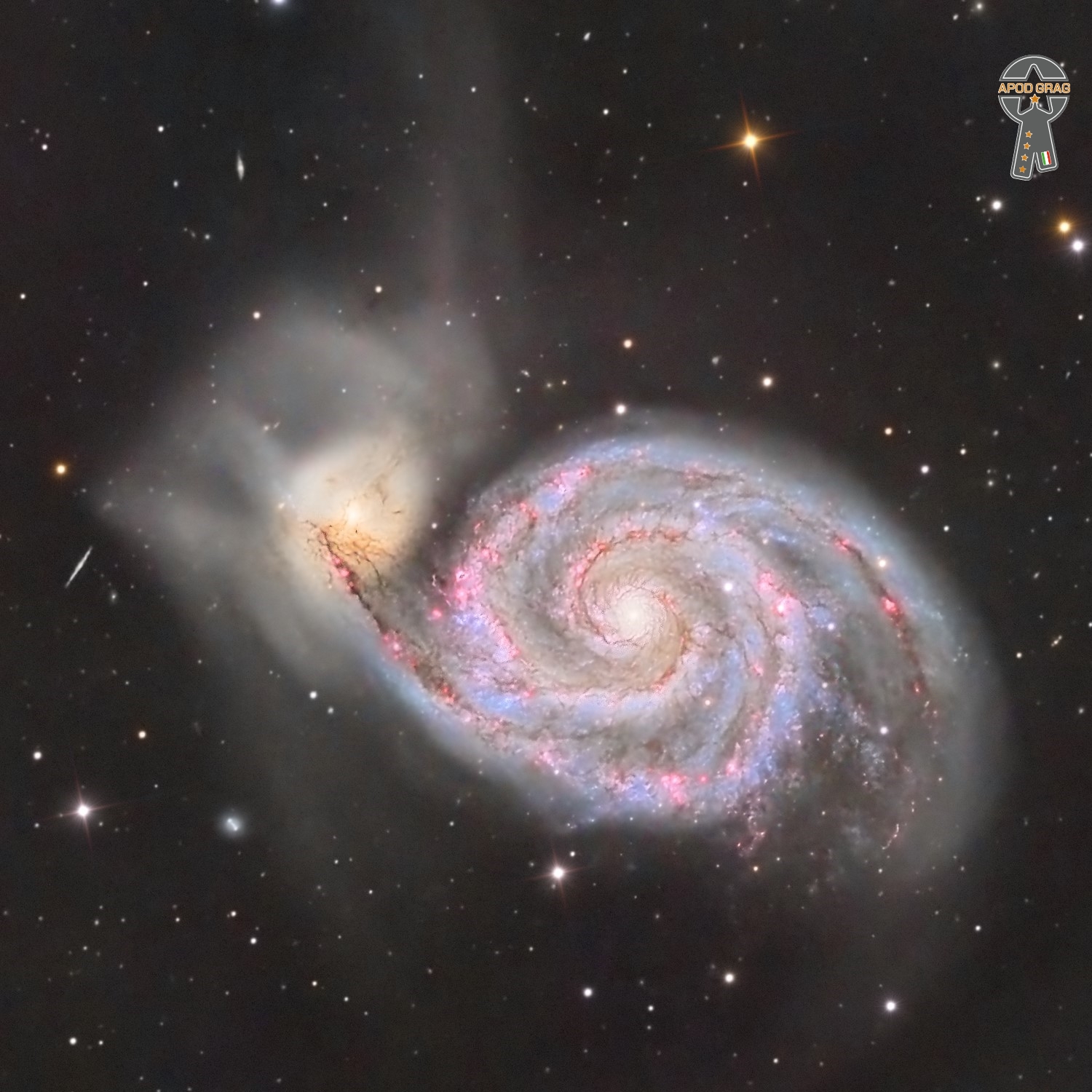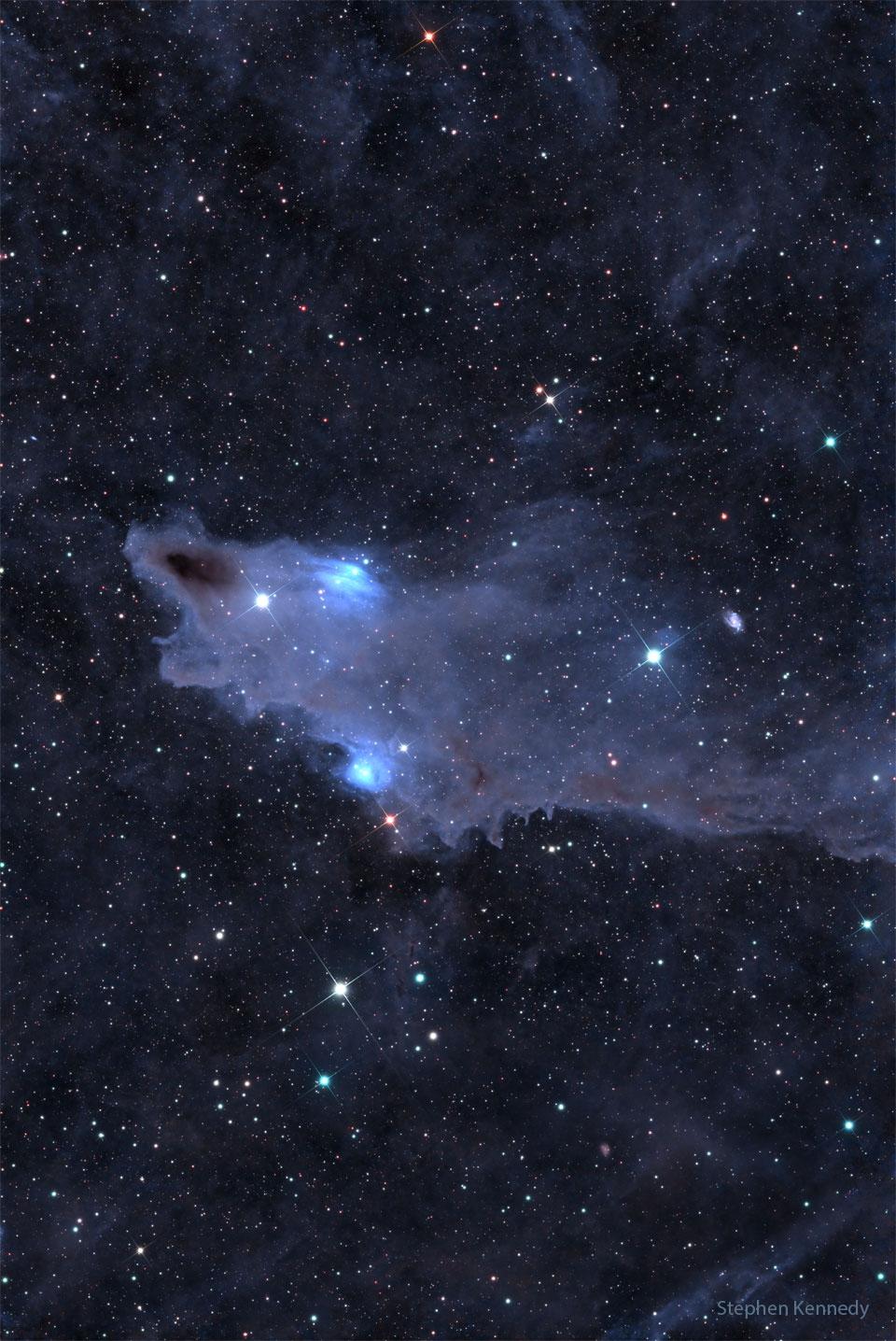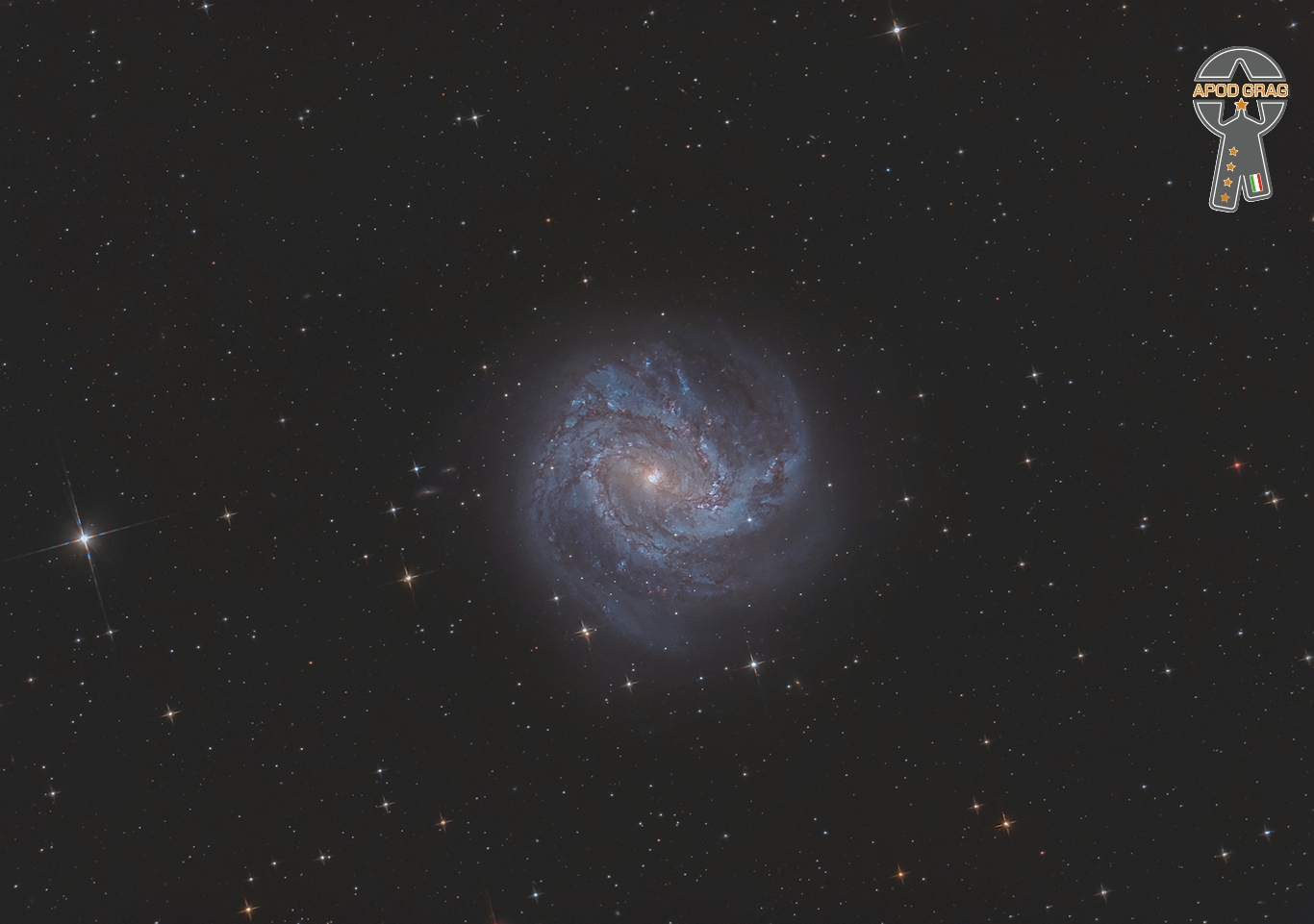Blog
- Introduction (Starting the dance)
- First Letra and Coletilla and 2nd Llamada
- 2nd Letra and Subida
- Silencio
- Castellana
- Escobilla
- Buleria de Cadiz
- Estribillo or TiritiTran
- Ending the piece
more...
The Whirlpool Galaxy, also known as Messier 51a (M51a) or NGC 5194, is an interacting grand-design spiral galaxy with a Seyfert 2 active galactic nucleus. It lies in the constellation Canes Venatici, and was the first galaxy to be classified as a spiral galaxy. It is between 23 and 31 million light-years away and 76,900 ly (23,580 pc) in diameter.
The galaxy and its companion, NGC 5195, are easily observed by amateur astronomers, and the two galaxies may be seen with binoculars. The Whirlpool Galaxy has been extensively observed by professional astronomers, and its pair with NGC 5195 who study it to understand galaxy structure (particularly structure associated with the spiral arms) and galaxy interactions. Its pair with NGC 5194is among the most famous and relatively close interacting systems, and thus is a favorite subject of galaxy interaction models.

Harry Edward Nilsson III (June 15, 1941 – January 15, 1994), sometimes credited as Nilsson, was an American singer-songwriter who reached the peak of his commercial success in the early 1970s. His work is characterised by pioneering vocal overdub experiments, returns to the Great American Songbook, and fusions of Caribbean sounds. A tenor with a 3+1⁄2 octave range, Nilsson was one of the few major pop-rock recording artists to achieve significant commercial success without ever performing major public concerts or undertaking regular tours.
Born in Brooklyn, Nilsson moved to Los Angeles as a teenager to escape his family’s poor financial situation. While working as a computer programmer at a bank, he grew interested in musical composition and close-harmony singing, and was successful in having some of his songs recorded by various artists such as the Monkees. In 1967, he debuted on RCA Victor with the LP Pandemonium Shadow Show, followed by a variety of releases that included a collaboration with Randy Newman (Nilsson Sings Newman, 1970) and the original children’s story The Point! (1971). He created the first remix album (Aerial Pandemonium Ballet, 1971) and recorded the first mashup song (“You Can’t Do That“, 1967). His most commercially successful album, Nilsson Schmilsson (1971), produced the international top 10 singles “Without You” and “Coconut“. His other top 10 hit, “Everybody’s Talkin’” (1968), was featured prominently in the 1969 film Midnight Cowboy. A version of Nilsson’s “One“, released by Three Dog Night in 1969, also reached the U.S. top 10.
Nillsson was known as a “singer-composer who is heard but not seen”, as he did not do concerts or shows. Prior to agreeing to be featured on an episode of director and producer’s Stanley Dorfman‘s In Concert series for the BBC, Nilsson had appeared only once, for a few moments, on television in Britain and once in America. Nilsson’s record producer, Richard Perry, referenced his lack of live performing in the book ‘The Record Producers’ by BBC Books, saying “He did do the In Concert series on BBC television with Stanley Dorfman, which was very popular at the time. His show was very interesting and innovative with a lot of new technology, multiple images and things like that, but I think any artist, with very few exceptions and none that I can really think of, can immeasurably enhance his career by appearing in front of the public. At some point, the public needs to reach out and touch the artist, experience and feel them in person.
Nilsson also appeared in a television special directed and produced by Stanley Dorfman for the BBC in 1973, entitled A Little Touch Of Schmilsson In The Night, which was filmed live in the BBC TV theatre in Shepherd’s Bush days after Nilsson and Frank Sinatra’s arranger Gordon Jenkins recorded Nilsson’s album by the same name with a live orchestra. With exception to three of his music videos, Nilsson only made five other appearances on film.
During a 1968 press conference, the Beatles were asked what their favourite American group was and answered “Nilsson”. Sometimes called “the American Beatle“, he soon formed close friendships with John Lennon and Ringo Starr. In the 1970s, Nilsson, Lennon and Starr were members of the Hollywood Vampiresdrinking club. They produced one collaborative album, Pussy Cats (1974). After 1977, Nilsson left RCA, and his record output diminished. In response to Lennon’s 1980 murder, he took a hiatus from the music industry to campaign for gun control. For the rest of his life, he recorded only sporadically.
In 1994, Nilsson died of a heart attack while in the midst of recording what became his last album, Losst and Founnd (2019).
The craft of Nilsson’s songs and defiant attitude he projected remain touchstones for later generations of indie rock musicians. Nilsson was voted No. 62 in Rolling Stone‘s 2015 list of the “100 Greatest Songwriters of All Time“, where he was described as “a pioneer of the Los Angeles studio sound” and “a crucial bridge” between 1960s psychedelia and the 1970s singer-songwriter era. The RIAA certified Nilsson Schmilsson and Son of Schmilsson (1972) as gold records, indicating over 500,000 units sold each. He earned two Grammy Awards (for “Everybody’s Talkin'” and “Without You”).
more...Nasheet Waits is an American jazz drummer.
Waits is a New York native who has been active on the jazz scene since early in his life. His father, percussionist Freddie Waits, died when Waits was 18.
Before pursuing a music career, Waits studied psychology and history at Morehouse College in Atlanta. He also holds a degree from Long Island University in music. While he was studying at L.I.U, instructor Michael Carvin secured Waits a spot in the percussion ensemble M’Boom, started by his father (Freddie Waits) and drummer Max Roach in 1970.
more...Joji “George” Kawaguchi (川口譲二) (June 15, 1927, Fukakusa, Kyoto – November 1, 2003, Tokyo) was a Japanese jazz drummer and bandleader. Kawaguchi was raised in Dairen, Manchukuo, at that time a Japanese-occupied territory. He played in his father’s ensemble as a teenager, and after World War II moved back to Japan, where he embarked on a career in jazz. He played first with an ensemble called the Azumanians, then joined the Big Four with Hidehiko Matsumoto, Hachidai Nakamura, and Mitsuru Ono; this ensemble played intermittently into the 1980s. He played extensively with Art Blakeyon tour in the 1980s. He recorded extensively as a leader; his sidemen included Isao Suzuki, Motohiko Hino, Takeshi Inomata, Donald Harrison, Terence Blanchard, Norio Maeda, Tatsuya Takahashi, and Nobuo Hara.
On July 22, 1966, he played with the John Coltrane quintet in Tokyo while the group was touring Japan.
more...John Arthur “Jaki” Byard ( June 15, 1922 – February 11, 1999) was an American jazzmulti-instrumentalist, composer, and arranger. Mainly a pianist, he also played tenor and alto saxophones, among several other instruments. He was known for his eclectic style, incorporating everything from ragtimeand stride to free jazz.
Byard played with trumpeter Maynard Ferguson in the late 1950s and early 1960s, and was a member of bands led by bassist Charles Mingus for several years, including on several studio and concert recordings. The first of his recordings as a leader was in 1960, but, despite being praised by critics, his albums and performances did not gain him much wider attention. In his 60-year career, Byard recorded at least 35 albums as leader, and more than 50 as a sideman. Byard’s influence on the music comes from his combining of musical styles during performance, and his parallel career in teaching.
From 1969 Byard was heavily involved in jazz education: he began teaching at the New England Conservatory of Music and went on to work at several other music institutions, as well as having private students. He continued performing and recording, mainly in solo and small group settings, but he also led two big bands – one made up of some of his students, and the other of professional musicians. His death, from a single gunshot while in his home, remains an unsolved mystery.
Byard was born in Worcester, Massachusetts, on June 15, 1922. At that time, his parents – John Sr and Geraldine Garr – were living at 47 Clayton Street. Both of his parents played musical instruments; his mother played the piano, as did his uncles and grandmother, the last playing in cinemas during the silent film era. He began piano lessons at the age of six, but they ended when his family was affected by the Great Depression. He was also given a trumpet that belonged to his father, and attempted to copy the popular players of the time, Roy Eldridge and Walter Fuller.
more...Erroll Louis Garner (June 15, 1921 – January 2, 1977) was an American jazz pianist and composer known for his swing playing and ballads. His instrumental ballad “Misty“, his best-known composition, has become a jazz standard. It was first recorded in 1956 with Mitch Miller and his orchestra, and played a prominent part in the 1971 motion picture Play Misty for Me.
Scott Yanow of Allmusic calls him “one of the most distinctive of all pianists” and a “brilliant virtuoso”.Garner received a star on the Hollywood Walk of Fame at 6363 Hollywood Boulevard. His live album Concert by the Sea first released in 1955, sold more than 1 million copies by 1958, and Yanow’s opinion on the album is that it “made such a strong impression that Garner was considered immortal from then on.”
Garner was born, along with twin brother Ernest in Pittsburgh, Pennsylvania on June 15, 1921, the youngest of six children. He attended George Westinghouse High School (as did fellow pianists Billy Strayhorn and Ahmad Jamal). Interviews with his family, music teachers, other musicians, and a detailed family tree can be found in Erroll Garner: The Most Happy Piano by James M. Doran.
more...PERFORMANCE DAY featuring the REDEMPTION DREAMERS percussion ensemble with Valencia Barnes singing Rivers of Babylon dressed in blue. The last in a series of the Rhythm Roots Workshop Residency at Cerenity Humboldt Senior Care center in St Paul. (https://cerenityseniorcare.org/cerenity-senior-care…/). 9th and FINAL in a series of 9 workshops exploring cultural rhythms from an array of world traditions. Wednesday June 14th 2023 130-3pm



the Shark nebula. This predator apparition poses us no danger as it is composed only of interstellar gas and dust. Dark dust like that featured here is somewhat like cigarette smoke and created in the cool atmospheres of giant stars. After being expelled with gas and gravitationally recondensing, massive stars may carve intricate structures into their birth cloud using their high energy light and fast stellar winds as sculpting tools. The heat they generate evaporates the murky molecular cloud as well as causing ambient hydrogen gas to disperse and glow red. During disintegration, we humans can enjoy imagining these great clouds as common icons, like we do for water clouds on Earth. Including smaller dust nebulae such as Lynds Dark Nebula 1235 and Van den Bergh 149 & 150, the Shark nebula spans about 15 light years and lies about 650 light years away toward the constellation of the King of Aethiopia (Cepheus).

William Henry Marcus Miller Jr. (born June 14, 1959) is an American musician, songwriter, and record producer. He is best known for his work as a bassist. He has worked with trumpeter Miles Davis, pianist Herbie Hancock, singer Luther Vandross, and saxophonist David Sanborn, among others. He was the main songwriter and producer on three of Davis’ albums: Tutu (1986), Music from Siesta (1987), and Amandla (1989). His collaboration with Vandross was especially close; he co-produced and served as the arranger for most of Vandross’ albums, and he and Vandross co-wrote many of Vandross’ songs, including the hits “I Really Didn’t Mean It“, “Any Love“, “Power of Love/Love Power” and “Don’t Want to Be a Fool“. He also co-wrote the 1988 single “Da Butt” for Experience Unlimited.
William Henry Marcus Miller Jr. was born in the Brooklyn borough of New York City on June 14, 1959. He grew up in a musical family; his father, William Miller, was a church organist and choir director. Through his father, he is the cousin of jazz pianist Wynton Kelly. He became classically trained as a clarinetist and later learned to play keyboards, saxophone, and guitar.
more...Jules Shungu Wembadio Pene Kikumba (14 June 1949 – 24 April 2016), known professionally as Papa Wemba , was a Congolese singer and musician who played Congolese rumba, soukous, and ndombolo. Dubbed the “King of Rumba Rock”, he was one of the most popular musicians of his time in Africa and played an important role in world music. He was also a fashion icon who popularized the Sape look and style through his musical group Viva la Musica, with whom he performed on stages throughout the world.
Papa Wemba’s road to fame and prominence began when he joined the music group Zaiko Langa Langa in the late 1960s. This was followed by his success as a founding member both of Isifi Lokole and then Yoka Lokole, along with a short stint as a member of Afrisa International for a few months. During these early stages of his career, he was establishing a style that included traditional Congolese rumba and soukous, infused with traditional African sounds, Caribbean rhythms, rock and soul. But Wemba gained international success and status with his band Viva La Musica, especially after he took them to Paris, France in the early 1980s. It was there that Wemba was able to achieve more of an “eclectic sound” in his work, influenced by western popular music that reflected a European flavor and style, referred to as “Europop.
more...Rodney Terence Argent (born 14 June 1945) is an English musician. In a career spanning more than 50 years, Argent came to prominence in the mid-1960s as the keyboardist, founder and leader of the rock band the Zombies, and went on to form the band Argent after the first break-up of the Zombies.
Argent is one of the main composers of the Zombies’ music and made major lyrical contributions to the band’s songs. As the band’s keyboardist he used a variety of instruments, including Hohner Pianet, Mellotron, harpsichord, and organ.
In addition to his work with the Zombies and Argent, Argent has made music for television series, been a session musician, produced albums by other artists, and had a solo career which has included three studio albums: Moving Home, Red House, and Classically Speaking. Argent was inducted into the Rock and Roll Hall of Fame as a member of the Zombies in Brooklyn in March 2019.
more...Autry DeWalt Mixon Jr. (June 14, 1931 – November 23, 1995), known professionally as Junior Walker, was an American multi-instrumentalist (primarily saxophonist) and vocalist who recorded for Motown during the 1960s. He also performed as a session and live-performing saxophonist with the band Foreigner during the 1980s.
Walker was born Autry DeWalt Mixon Jr. on June 14, 1931, in Blytheville, Arkansas, but grew up in South Bend, Indiana. He began playing saxophone while in high school, and his saxophone style was the anchor for the sound of the bands he later played in.
His career started when he developed his own band in the mid-1950s as the Jumping Jacks. His longtime friend and drummer Billy Nicks (1935–2017) formed his own group, the Rhythm Rockers. Periodically, Nicks would sit in on Jumping Jack’s shows, and Walker would sit in on the Rhythm Rockers shows.
more...Messier 83 or M83, also known as the Southern Pinwheel Galaxy and NGC 5236, is a barred spiral galaxy approximately 15 million light-years away in the constellation borders of Hydra and Centaurus. Nicolas-Louis de Lacaille discovered M83 on 23 February 1752 at the Cape of Good Hope. Charles Messier added it to his catalogue of nebulous objects (now known as the Messier Catalogue) in March 1781.
It is one of the closest and brightest barred spiral galaxies in the sky, and is visible with binoculars. It has an isophotal diameter at about 36.24 kiloparsecs (118,000 light-years). Its nickname of the Southern Pinwheel derives from its resemblance to the Pinwheel Galaxy (M101).

Uriel Jones (June 13, 1934 – March 24, 2009) was an American musician. Jones was a recording session drummer for Motown‘s in-house studio band, the Funk Brothers, during the 1960s and early 1970s.
Jones was first hired by Motown as a fill-in for principal drummer Benny Benjamin; along with Richard “Pistol” Allen, he moved up the line as recordings increased and Benjamin’s health deteriorated. Hits that Jones played drums on include “Ain’t No Mountain High Enough” – both versions, by Marvin Gaye & Tammi Terrellin 1967 and the 1970 remake by Diana Ross, “I Heard It Through the Grapevine” and “Ain’t That Peculiar” by Marvin Gaye, “Cloud Nine” (in which he was augmented by Spider Webb), “I Can’t Get Next to You“, and “Ain’t Too Proud to Beg” by the Temptations, “What Becomes of the Brokenhearted” by Jimmy Ruffin, Jr. Walker‘s “Home Cookin’,” “The Tracks of My Tears” and “I Second That Emotion” by Smokey Robinson & the Miracles, and “For Once in My Life” by Stevie Wonder. His influences included jazz drummer Art Blakey. For his Motown recordings, Jones performed on a studio set composed of Ludwig, Slingerland, Rogers and Gretsch components and possibly Zildjian cymbals. Jones became better known to music fans through his appearance in the feature documentary film, Standing in the Shadows of Motown. Motown arranger Paul Riser said of Jones that “Uriel’s drum sound was the most open and laid-back, and he was the funkiest of the three guys we had…He had a mixed feel and did a lot of different things well.”
more...More Posts
- Echos of Freedom by Rabindranath Tagore
- Happy Valentines Day 2025
- Little Shop of Horrors
- Cosmo NGC 2237
- Merl Saunders
- Tim Buckley
- Magic Sam
- Flamenco Fridays Gipsy Kings
- Daily Roots Playing for Change
- Echoes of Freedom James Baldwin
- SORRY FOR YOUR LOSS IS NOT HELPFUL
- Judy Dyble
- “Rebop” Kwaku Baah
- Little Shop of Horrors 2025
- Cosmo VdB 31
- Peter Gabriel
- King Floyd
- Wardell Gray
- World Music Baba Sissoko
- Daily Roots Musical Intimidator (Tapper Zukie)